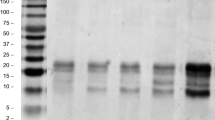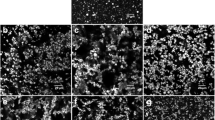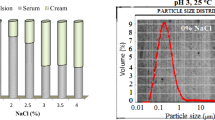Abstract
The present work investigated the physicochemical properties of O/W emulsions containing functional ingredients (oil with high ω-3 fatty acid content, protein and/or soluble fiber) from chia seeds. The effect of different protein–carbohydrate combinations (sodium caseinate and lactose, sodium caseinate and maltodextrin, chia protein-rich fraction and maltodextrin) and the presence of chia mucilage (0 and 0.2 % wt/wt) in the aqueous phase of chia O/W emulsions was studied as a function of droplet size distribution, Sauter mean diameter, ζ-potential, rheological properties and backscattering profiles. The use of sodium caseinate in combination with lactose or maltodextrin produced chia O/W emulsions with small droplet size (0.22–0.27 µm), high degree of uniformity in droplet size distribution, negatively charged droplets (at pH 6.5), pseudoplastic behavior and high physical stability. Emulsions with chia protein-rich fraction presented wider droplet size distribution and higher D[3,2] values than the previous ones, recording a Newtonian behavior. The addition of chia mucilage affected the physicochemical properties studied, mainly the rheological characteristics of emulsions.


Similar content being viewed by others
References
Ayerza R, Coates W (2005) Ground chia seed and chia oil effects on plasma lipids and fatty acids in the rat. Nutr Res 25:995–1003. doi:10.1016/j.nutres.2005.09.013
Ayerza R, Coates W (2011) Protein content, oil content and fatty acid profiles as potential criteria to determine the origin of commercially grown chia (Salvia hispanica L.). Ind Crop Prod 34:1366–1371. doi:10.1016/j.indcrop.2010.12.007
Bushway A, Belyea P, Bushway R (1981) Chia seed as a source of oil, polysaccharide, and protein. J Food Sci 46:1349–1350
Cabezas D, Madoery R, Diehl B, Tomás M (2012) Emulsifying properties of different modified sunflower lecithins. J Am Oil Chem Soc 89:355–361
Capitani MI, Ixtaina VY, Nolasco SM, Tomas MC (2013) Microstructure, chemical composition and mucilage exudation of chia (Salvia hispanica L.) nutlets from Argentina. J Sci Food Agric 93:3856–3862. doi:10.1002/jsfa.6327
Capitani MI, Corzo-Rios LJ, Chel-Guerrero LA, Betancur-Ancona DA, Nolasco SM, Tomás MC (2015) Rheological properties of aqueous dispersions of chia (Salvia hispanica L.) mucilage. J Food Eng 149:70–77. doi:10.1016/j.jfoodeng.2014.09.043
Day L, Xu M, Hoobin P, Burgar I, Augustin M (2007) Characterisation of fish oil emulsions stabilised by sodium caseinate. Food Chem 105:469–479
Dickinson E (1999) Caseins in emulsions: interfacial properties and interactions. Int Dairy J 9:305–312. doi:10.1016/S0958-6946(99)00079-5
Dickinson E (2003) Hydrocolloids at interfaces and the influence on the properties of dispersed systems. Food Hydrocoll 17:25–39
Dickinson E, McClements DJ (1995) Molecular basis of protein functionality. In: Advances in food colloids. Blackie Academic and Professional, Glasgow
Hogan SA, McNamee BF, O’Riordan ED, O’Sullivan M (2001) Microencapsulating properties of sodium caseinate. J Agric Food Chem 49:1934–1938. doi:10.1021/jf000276q
Ixtaina VY et al (2011a) Characterization of chia seed oils obtained by pressing and solvent extraction. J Food Comp Anal 24:166–174
Ixtaina VY, Mattea F, Cardarelli DA, Mattea MA, Nolasco SM, Tomás MC (2011b) Supercritical carbon dioxide extraction and characterization of Argentinean chia seed oil. J Am Oil Chem Soc 88:289–298
Ixtaina VY, Nolasco SM, Tomás MC (2012) Oxidative stability of chia (Salvia hispanica L.) seed oil: effect of antioxidants and storage conditions. J Am Oil Chem Soc 89:1077–1090
Ixtaina VY, Julio LM, Wagner JR, Nolasco SM, Tomás MC (2015) Physicochemical characterization and stability of chia oil microencapsulated with sodium caseinate and lactose by spray-drying. Powder Technol 271:26–34. doi:10.1016/j.powtec.2014.11.006
Jafari SM, Beheshti P, Assadpour E (2013) Emulsification properties of a novel hydrocolloid (Angum gum) for d-limonene droplets compared with Arabic gum. Int J Biol Macromol 61:182–188. doi:10.1016/j.ijbiomac.2013.06.028
Julio LM, Ixtaina VY, Fernández MA, Sánchez RMT, Wagner JR, Nolasco SM, Tomás MC (2015) Chia seed oil-in-water emulsions as potential delivery systems of ω-3 fatty acids. J Food Eng 162:48–55
Klinkesorn U, Sophanodora P, Chinachoti P, McClements DJ (2004) Stability and rheology of corn oil-in-water emulsions containing maltodextrin. Food Res Int 37:851–859
Liang Y, Gillies G, Patel H, Matia-Merino L, Ye A, Golding M (2014) Physical stability, microstructure and rheology of sodium-caseinate-stabilized emulsions as influenced by protein concentration and non-adsorbing polysaccharides. Food Hydrocoll 36:245–255
Lin K-Y, Daniel JR, Whistler RL (1994) Structure of chia seed polysaccharide exudate. Carbohydr Polym 23:13–18
Mann JI, Cummings JH (2009) Possible implications for health of the different definitions of dietary fibre. Nutr Metab Cardiovas 19:226–229. doi:10.1016/j.numecd.2009.02.002
Martínez ML, Marín MA, Salgado Faller CM, Revol J, Penci MC, Ribotta PD (2012) Chia (Salvia hispanica L.) oil extraction: study of processing parameters. LWT Food Sci Technol 47:78–82. doi:10.1016/j.lwt.2011.12.032
McClements DJ (2004) Food emulsions: principles, practices, and techniques. CRC Press, Boca Raton
Mengual O, Meunier G, Cayré I, Puech K, Snabre P (1999) TURBISCAN MA 2000: multiple light scattering measurement for concentrated emulsion and suspension instability analysis. Talanta 50:445–456
Mohd Ali N, Yeap SK, Ho WY, Beh BK, Tan SW, Tan SG (2012) The promising future of chia Salvia hispanica L. Biomed Res Int. doi:10.1155/2012/171956
O’Dwyer SP, O’Beirne D, Eidhin DN, O’Kennedy BT (2013) Effects of sodium caseinate concentration and storage conditions on the oxidative stability of oil-in-water emulsions. Food Chem 138:1145–1152. doi:10.1016/j.foodchem.2012.09.138
Olivos-Lugo B, Valdivia-López M, Tecante A (2010) Thermal and physicochemical properties and nutritional value of the protein fraction of Mexican chia seed (Salvia hispanica L.). Food Sci Technol. doi:10.1177/1082013209353087
Pan L, Tomás M, Añón M (2002) Effect of sunflower lecithins on the stability of water-in-oil and oil-in-water emulsions. J Surfactants Deterg 5:135–143
Qian C, McClements DJ (2011) Formation of nanoemulsions stabilized by model food-grade emulsifiers using high-pressure homogenization: factors affecting particle size. Food Hydrocoll 25:1000–1008. doi:10.1016/j.foodhyd.2010.09.017
Reyes-Caudillo E, Tecante A, Valdivia-López M (2008) Dietary fibre content and antioxidant activity of phenolic compounds present in Mexican chia (Salvia hispanica L.) seeds. Food Chem 107:656–663
Rodea-González DA, Cruz-Olivares J, Román-Guerrero A, Rodríguez-Huezo ME, Vernon-Carter EJ, Pérez-Alonso C (2012) Spray-dried encapsulation of chia essential oil (Salvia hispanica L.) in whey protein concentrate-polysaccharide matrices. J Food Eng 111:102–109. doi:10.1016/j.jfoodeng.2012.01.020
Sandoval-Oliveros MR, Paredes-López O (2012) Isolation and characterization of proteins from chia seeds (Salvia hispanica L.). J Agric Food Chem 61:193–201
Segura-Campos MR, Ciau-Solís N, Rosado-Rubio G, Chel-Guerrero L, Betancur-Ancona D (2014) Chemical and functional properties of chia seed (Salvia hispanica L.) gum. Int J Food Sci. doi:10.1155/2014/241053
Timilsena YP, Adhikari R, Kasapis S, Adhikari B (2016) Molecular and functional characteristics of purified gum from Australian chia seeds. Carbohydr Polym 136:128–136. doi:10.1016/j.carbpol.2015.09.035
Vázquez-Ovando A, Betancur-Ancona D, Chel-Guerrero L (2012) Physicochemical and functional properties of a protein-rich fraction produced by dry fractionation of chia seeds (Salvia hispanica L.). CyTA J Food 11:75–80. doi:10.1080/19476337.2012.692123
Wang Y, Li D, Wang L-J, Adhikari B (2011) The effect of addition of flaxseed gum on the emulsion properties of soybean protein isolate (SPI). J Food Eng 104:56–62
Acknowledgments
The authors would like to acknowledge the financial support of Agencia Nacional de Promoción Científica y Tecnológica (ANPCyT) PICT 2013-0563, Consejo Nacional de Investigaciones Científicas y Técnicas (CONICET) PIP 0713 and Universidad Nacional de La Plata (UNLP) 11/X610, Argentina, the donation of maltodextrin by INDECAR S.A.I.C.y F., Pablo Salgado, Santiago Suárez (CIDCA) and Jorge Wagner (Universidad Nacional de Quilmes, Argentina) for their technical assistance.
Author information
Authors and Affiliations
Corresponding author
Rights and permissions
About this article
Cite this article
Julio, L.M., Ixtaina, V.Y., Fernández, M. et al. Development and characterization of functional O/W emulsions with chia seed (Salvia hispanica L.) by-products. J Food Sci Technol 53, 3206–3214 (2016). https://doi.org/10.1007/s13197-016-2295-8
Revised:
Accepted:
Published:
Issue Date:
DOI: https://doi.org/10.1007/s13197-016-2295-8




